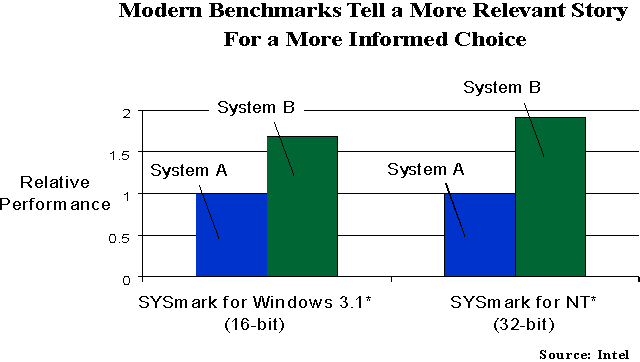
6. Practice Problems and Solutions

Problem 1
Answer the following questions related to different types of benchmarks presented
in Section 2:
- Distinguish between system-level benchmarks and component-level benchmarks.
- Name any three subsystems of a computer organization that can be tested with
component-level benchmarks.
- What level of benchmarks would you use to measure the performance of
multi-layered cache in the memory hierarchy of your computer?
- What type of benchmarks would you use to evaluate a massively parallel
system built with multiple-context processors and a 3-D torus architecture?
- Describe two drawbacks of application benchmarks.
Problem 1 Solutions:
- System-level benchmarks measure the overall performance of a machine, whereas
component-level benchmarks measure the performance of a subsystem.
-
- Component-level benchmarks
- Application benchmarks
- Large and difficult to execute
- Subject to the developer's
interpretation of real usage.
Problem 2
You are given the ZD Winstone97 benchmark results of two different processors as
follow:
| PR233 Cyrix 6x86MX processor |
52.3 |
| Pentium II processor 233 MHz | 51.8 |
-
What conclusion can you draw about the relative performance of these two
processors?
- Name four factors that must be kept constant during this benchmarking
process.
Problem 2 Solution:
-
Winstone 97 benchmark is a system-level application benchmark that measures a
PC's overall performance when running Windows-based 32-bit business applications.
Thus a PC with Cyrix 6x86MX processor will run those applications faster than
a PC with Pentium II 233 MHz processor.
- Version of the compiler
- Version of the OS
- Size and speed of
cache
- Amount of Main Memory
Problem 3
Indicate whether each of the following statements is true or
false and justify your answer with reasoning and supportive or counter
examples:
- Synthetic benchmarks predict performance of real programs.
- Factors influencing the usefulness of a benchmark remain valid indefinitely.
- Improving the performance of an old benchmark by optimizing the compiler is
one way of updating the benchmark.
- Application benchmarks reflect the typical nature of the workload better than
synthetic benchmarks.
- Synthetic benchmarks are shorter and easier to run than application benchmarks, and thus they are better performance metrics.
Problem 3 Solution:
- false - Synthetic benchmarks simulate real programs, and do not
reflect the actual behavior of real programs.
- false - Improvements in technology lead to the necessity of
revising old and obsolete benchmarks.
- fasle - Compiler optimization can change what a benchmark
measures producing inaccurate benchmark results.
- true - Application benchmarks are real programs.
- false - They simulate real programs.
Problem 4
The chart below summarizes the benchmark results obtained by running SYSmark for
Windows 3.1*, a 16-bit benchmark, on two systems, A and B, and the results from
SYSmark for NT*, a 32-bit benchmark.

- Which benchmark results are more reliable? Why?
- Suggest a reason why SYSmark for Windows 3.1* can predict the performance
of system A consistently, but cannot give the true performance of system
B.
- If the benchmark performance score of system B is 40.35 for 32-bit
benchmark, and 32.8 for 16-bit benchmark respectively, and the performance
differences of system A and system B are 1.91 and 1.68 respectively, compute
the benchmark performance scores of system A for both benchmarks.
Problem 4 Solution:
- SYSmark/NT* benchmark results are more reliable because it is more up-to-date
than SYSmark for Windows 3.1*, and thus takes into account of
sophisticated capabilities of the two systems that SYSmark for Windows 3.1*
might have overlooked.
- System A may be a 16-bit architecture machine, and thus a 16-bit benchmark,
SYSmark for Windows 3.1*, can represent the workload for system A more
consistently than it does for system B. System B may be a 32-bit
architecture machine, and thus a 16-bit benchmark cannot test the performance
effectively.
- SYSmark/NT* performance score of A = 40.35 - 1.91 = 38.44
SYSmark Windows 3.1* performance score of A = 32.8 - 1.68 = 31.12
Problem 5
You are given the following terms :
- throughput
- speed
- cracking
- compiler efficiency
- simulations of
real applications
Supply the missing words in the following sentences from the above list:
- System-level benchmarks can be used to predict the _________________________
of a PC running real applications with Cyrix 6x86MX processor.
- The most important characteristic of a reliable benchmark is its ability
to resist _________________________.
- _________________________ and _________________________ are two performance
metrics that a typical application benchmark measures.
- Improving the _________________________ of a system while other variables
are kept constant during benchmarking will not yield the accurate result.
- Application benchmarks are more reliable than synthetic benchmarks because
they are not _________________________.
Problem 5 Solutions:
- speed
- cracking
- Throughput, speed
- compiler efficiency
- simulations of real applications

Overview |
Introduction |
Types |
Engineering |
Reporting |
Revising |







